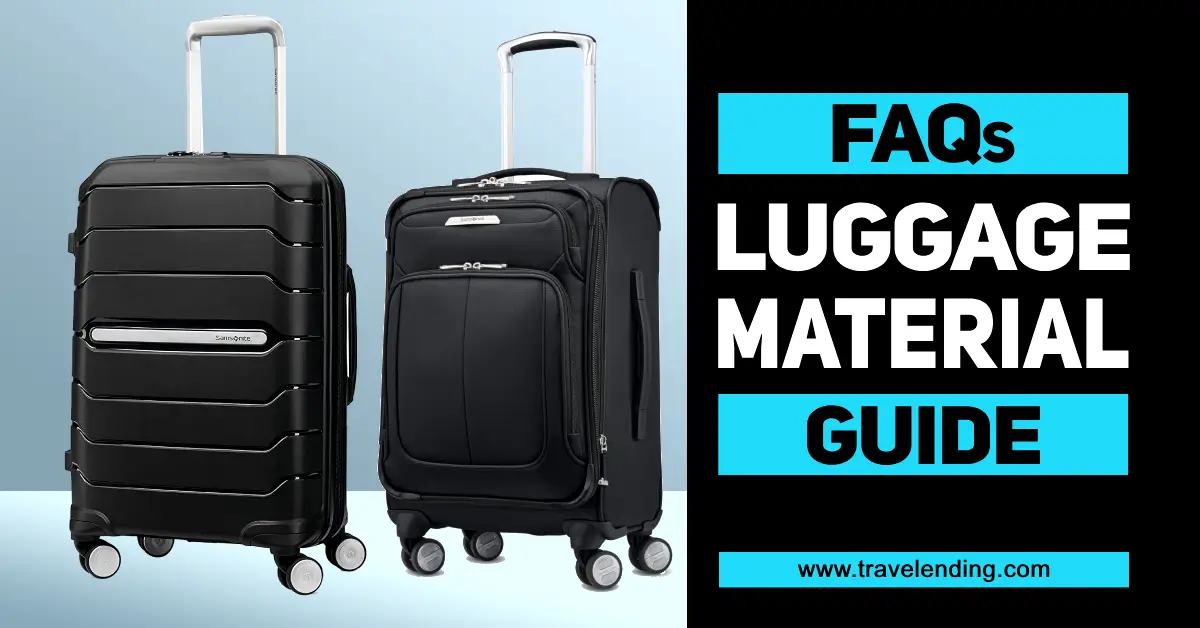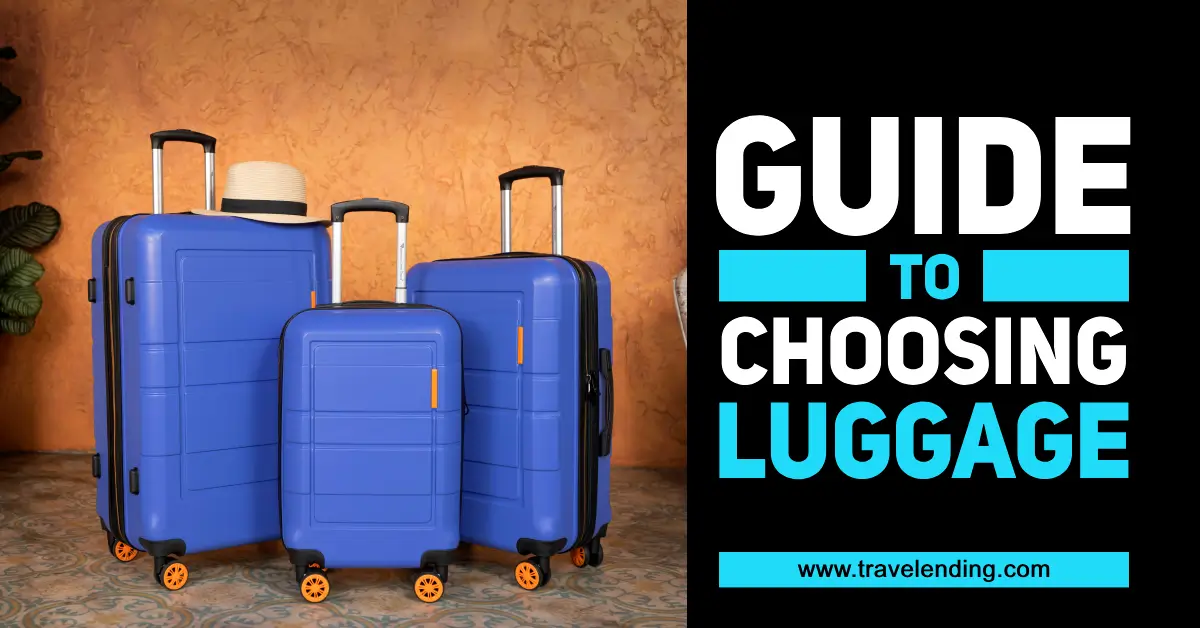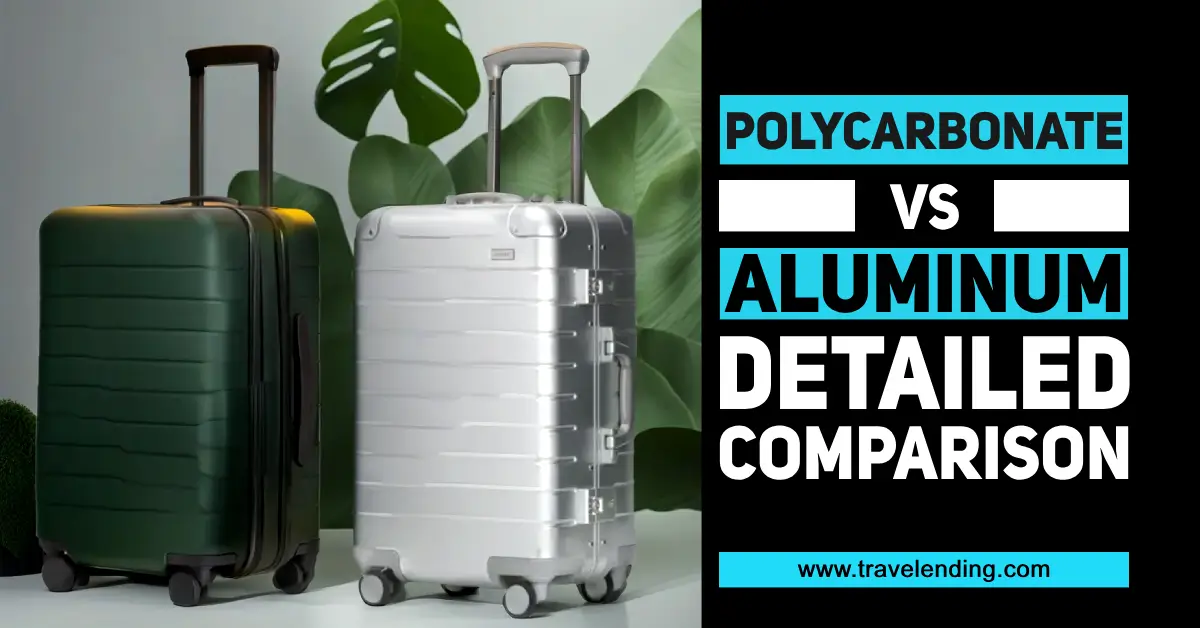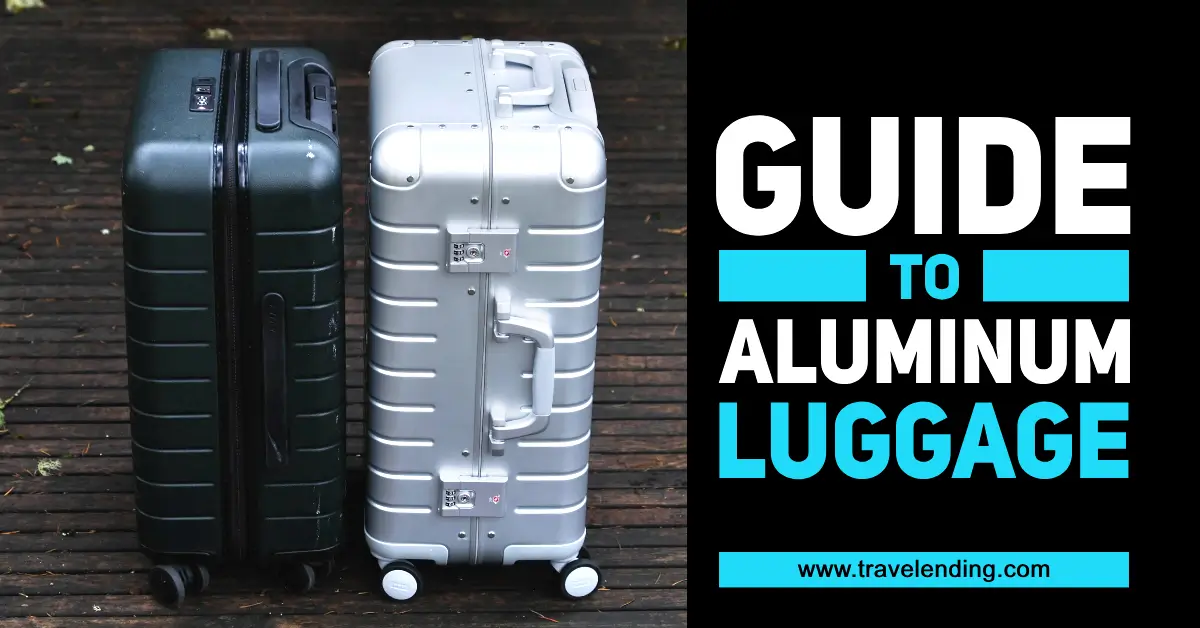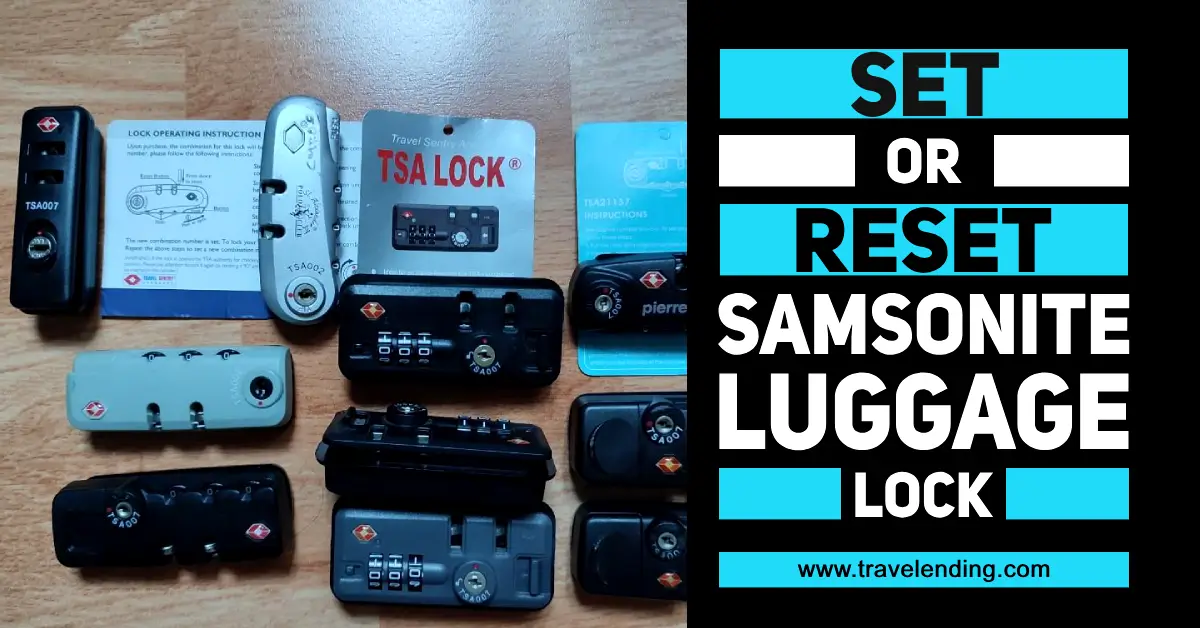Luggage Materials FAQs Guide: Most Frequently Asked Questions Covered
Welcome to our luggage material FAQs guide, where we’ve compiled all the most frequently asked questions about luggage materials. Because luggage material is the most important factor that determines the durability of a piece of luggage.
In this guide to luggage material, we’ll dive into the pros and cons of different luggage materials, including polycarbonate, polypropylene, ABS, aluminum, polyester, and nylon, and also compare them with each other.
We’ve already done a detailed guide on each material that we’ll link out wherever we need it. So stay with us to get the answer to the most common concerns that most travelers have when choosing any piece of luggage.
Table of Contents
Which is the best and most durable luggage material?
Hardside Luggage Material
Various materials are used to make suitcases, such as aluminum, polycarbonate, and ABS, and all of them are known for their benefits and drawbacks. Each material fulfills different purposes.
But of all the materials that are used to manufacture hardside suitcases, polycarbonate is the best and most durable material because of its lightweight properties, ultimate durability and flexibility, and scratch-resistant finish.
Polycarbonate is also weather-resistant but a little expensive compared to polypropylene and ABS hardside luggage material. If you’re curious to know more about the best material for luggage, please read this guide on the best luggage material.
Softside Luggage Material
For softside luggage materials, there are various materials, but the most common and durable materials are polyester, nylon, and ballistic nylon.
Again, each material comes with its pros and cons. Of all the softside luggage materials, polyester is the most commonly used material, mainly because of its affordability. Polyester is durable enough, but not as durable as nylon and ballistic nylon.
For those tight on budget, polyester is a great choice. But if you spend a little more, you must go with either nylon or ballistic nylon, as they are way more durable and last from ten years to a lifetime.
Is polycarbonate luggage worth it?
Yes, polycarbonate is really worth it; it’s the best material out there on the market. It’s lightweight, durable, flexible, and affordable as well. No matter what type of traveler you are, you can go with polycarbonate luggage.
Here are the best polycarbonate luggage options you can consider for any purpose;
Best Polycarbonate Luggage
Samsonite Omni PC (Most Affordable)
Delsey Paris Helium Aero (Best Overall)
Travelpro Platinum Elite (Most Durable)
Samsonite Outline Pro (Most Stylish)
Away Carry On (Most Premium)
Polycarbonate or polypropylene: which is better?
Both polycarbonate and polypropylene are excellent choices; both are excellently durable, flexible, lightweight, and affordable. But comparing both materials side by side, polycarbonate outperforms polypropylene.
There are a few reasons. No doubt, polypropylene is durable and flexible, but polycarbonate is even more durable and flexible, giving it more ability to withstand and absorb the shocks that luggage comes through at the time of baggage handling at airports.
But in terms of weight and affordability, polypropylene becomes a better choice because, on average, it’s around 12% lighter than polycarbonate, making it the lightest of all the materials. It’s generally less expensive than polycarbonate.
But you should spend a little if you budget and go with polycarbonate because the price difference is not that much considering the quality difference. If you want to know more in detail, here is a complete guide on the comparison between polycarbonate and polypropylene luggage materials.
The best example of polypropylene luggage is the Samsonite Freeform spinner luggage, you can consider getting it, it has been positively reviewed by thousands of people.
Is polypropylene more expensive than polycarbonate?
No; generally, polypropylene is less expensive than polycarbonate. Polycarbonate is mostly more expensive, but the price difference is not that much.
We always recommend going with polycarbonate luggage, especially if it’s checked luggage, as polycarbonate is more capable of handling rough handling by baggage handlers.
ABS or polycarbonate: which is better?
Both materials are the most popular of all the luggage materials. But in terms of quality, there is a huge difference between both of them in every aspect.
Whether it’s durability, price, flexibility, or weight. ABS is not only less durable than polycarbonate but also all other luggage materials. It’s the least flexible material, making it more prone to damage and cracking.
On the other hand, polycarbonate is way more durable and flexible than ABS luggage material, which ultimately makes it more capable of lasting a longer period.
No doubt, ABS is more affordable and lightweight, but you already know that quality comes at a cost. That applies to polycarbonate material. If you can spend a little more, polycarbonate is the way to go.
But it never means that ABS is worthless; considering the price, ABS luggage is also considerable, especially if you’re an occasional or leisure traveler. It can also last for 3–5 years if you take care of it properly. Here is the complete comparison guide: polycarbonate vs. ABS luggage material.
Here are a few best ABS luggage options you can consider:
Polypropylene or ABS: Which is better?
What we explained above about polypropylene and ABS material, somewhat applies here as well. Polypropylene is more durable, flexible, and lightweight than ABS.
Talking about price and affordability, ABS is more affordable, and in fact, it’s the cheapest luggage material of all other luggage materials.
If you want to know more, read this guide.
Aluminum or polycarbonate: which is better?
Both materials are the most durable, and they have their own advantages and disadvantages. Aluminum is the most durable hardside luggage material; no other material is close to it. It’s non-flexible in nature; it doesn’t crack; it only gets bends or dents.
Aluminum outperforms polycarbonate in every aspect except two: weight and price. No doubt it’s the most durable material, but it’s the heaviest of all the materials as well. Weight is the biggest concern when traveling by air.
Another disadvantage is that it’s way more expensive than polycarbonate, especially if you go with any reliable brand like Tumi, Rimova, or Away. On the other hand, polycarbonate is more affordable and lightweight compared to aluminum.
If you want to know more in detail, you can read this extensive guide on polycarbonate vs. aluminum luggage material.
Do hard suitcases crack easily?
It depends on the material you choose for your luggage. The more flexible the luggage is, the more difficult it is to crack. If you choose ABS luggage, it’s more likely to crack or break because of its lack of flexibility.
But if you go with polypropylene or polycarbonate, these materials are less likely to crack or break because they are more flexible. With polycarbonate, it’s even less likely to crack because it’s the most flexible hardside luggage material.
So it’s highly recommended for you to go with polycarbonate luggage for better durability and longevity.
Is polyester or nylon better for luggage?
Both softside luggage materials are excellent; they’re even capable of handling frequent travel. When we compare both materials side by side, undoubtedly, nylon is the clear winner. Let’s take a look. Why?
For softside luggage, polyester is the most popular material, accounting for around 70% of the total softside luggage market share. Even if you’re a frequent traveler, you can consider getting polyester luggage.
But compared with polyester luggage, nylon is more durable and tear-resistant. Despite being more durable, it’s lighter than polyester. Nylon is used in premium and high-end suitcases, while polyester is used in medium-class and affordable suitcases.
So if you want something more rugged, rough, and tough, you can go with nylon luggage, if you’re limited on budget and don’t need a high-end suitcase, you can go with polyester as well.
If you want to know more about softside luggage material; check out this luggage material guide on the clever journey.
Is polyester a good material for luggage?
Yes, polyester is a good material for luggage; it’s the most popular softside luggage material. Polyester is quite durable, tear-resistant, and lightweight. Whether you’re a frequent traveler, a business traveler, or an occasional traveler, you can go with it.
But if you want something even more durable and rugged and don’t have any budget issues, you can go for nylon material. As it’s even more long-lasting and tear-resistant than polyester, you can choose nylon luggage for extended and ultimate durability.
Which is better, a hard shell or soft luggage?
Both materials have their own pros and cons and are perfect for different purposes. Let’s take a look at the advantages and disadvantages of both materials so that you can decide which one you should go for.
Pros and Cons of Hard Shell Luggage
| ADVANTAGES | DISADVANTAGES |
|---|---|
| Excellent Durability | Comparatively Heavier |
| Water Resistant | Difficulty in Squeezing |
| Better Security | Generally, No Exterior Pocket. |
| Better Design Options | |
| Easy Cleaning |
Pros and Cons of Soft Shell Luggage
| ADVANTAGES | DISADVANTAGES |
|---|---|
| Easy to Squeeze and Fit Anywhere | Not Water Resistant |
| Better Organization and Pockets | Comparatively Weaker Protection |
| Comparatively Lightweight | Hard to Clean |
| Available with Both Roller and Spinner Wheels | Less Design Options |
Here is a quick overview of both types of luggage. If you want to know more about both types of luggage, you can read this guide on hardside and softside luggage.

